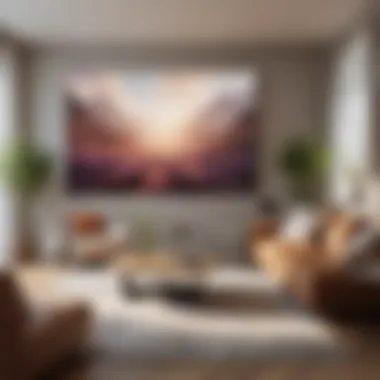Determining the Ideal Size of Art for Your Walls


Intro
Choosing the correct size of artwork for your walls is a task that combines both aesthetic and practical considerations. It is not simply about filling a void; it is about creating an atmosphere that resonates with the overall design of the space. The size of the art pieces can dramatically alter the perception of a room, influencing mood and focus. Thus, understanding how to select artworks that match the dimensions and style of your interior can greatly enhance your living experience.
The factors influencing art size are numerous. These include the dimensions of the room, the style of décor, and the visual impact you wish to achieve. The interplay between these elements can either create harmony or lead to disarray. Ultimately, the aim is to cultivate a space that reflects personal taste while adhering to design principles.
Design Inspiration
Design inspiration is the foundation upon which the selection of art sizes and styles is built. It relates directly to current trends in interior design which constantly evolve, guiding homeowners in creating visually appealing environments.
Current Trends in Interior Design
The latest trends in interior design place a strong emphasis on versatility and individuality. Here are a few design directions worth considering:
- Minimalism: This style encourages simplicity. Larger art pieces often serve as focal points, allowing them to stand out against unembellished backgrounds.
- Eclectic designs: An eclectic approach welcomes variety. Here, a mix of art sizes can showcase the homeowner's personality and experiences through diverse mediums.
- Industrial Style: In industrial settings, oversized artworks can enhance the robust aesthetics of raw materials like exposed brick and metal.
- Bohemian Chic: Layered textures characterize this style. Smaller art pieces can be grouped together for a cohesive look, rather than using one central piece.
Understanding these trends equips you with the knowledge needed to make informed choices about the size of artwork.
Color Schemes and Palette Ideas
Art size selection should also harmonize with the color palette of your room. The impact of color cannot be overstressed, as it shapes the entire environment's feelings. Consider these basic ideas for blending art sizes with your colors:
- Complementary Colors: Choose artwork that includes colors present in your room's decor for a unified look.
- Bold Colors and Patterns: Larger, vibrant pieces can serve as a statement, while smaller artworks can introduce subtle accents.
- Muted Tones: In spaces dominated by neutral colors, smaller art can add a visual anchor without overwhelming the environment.
By keeping these factors in mind, you can enhance the visual coherence and overall impact of your interior design.
Prelims to Art Sizing
Selecting the right size of art for your walls is a nuanced process that requires careful consideration of various elements. The significance of this topic cannot be overstated, as the appropriate artwork can profoundly affect the ambience and aesthetic of any space. When individuals put thought into art sizing, they can better create a harmonious environment that reflects their personal style.
The importance of art sizing lies in its ability to enhance or detract from the room's overall design. A piece that is either too large or too small may create imbalance, leading to a disruption of visual harmony. By understanding the principles behind art sizing, homeowners can avoid common pitfalls and make informed decisions that elevate their interiors.
Key Factors to Consider
- Room Dimensions: Understanding the size of the walls and the overall room layout is crucial.
- Furniture Arrangement: Art should complement and harmonize with existing furniture and décor.
- Intended Mood: Different sizes and styles can evoke various feelings in a space.
- Personal Style: The size of art should resonate with the individual’s taste and the room's theme.
Art sizing involves a balance of aesthetics and function. Opting for a piece that fits well within the designated space can transform a room from ordinary to extraordinary. It is not merely a matter of personal preference; it is about achieving a cohesive look that works for the environment. As we explore the nuances of this subject further, we will unpack how to assess visual weight, proportions, and the interplay between art and surrounding elements, ultimately guiding readers toward achieving their ideal art selections.
Understanding Visual Weight
Visual weight is an important concept in the realm of art and interior design. It refers to the perceived "weight" of an artwork that influences how it interacts with other elements in the space. This notion has significant implications when considering the size of art for your walls. Understanding visual weight helps determine how artwork can shape the atmosphere of a room and draw attention to key features.
When an art piece has a larger visual weight, it commands more attention within a space. This can be due to various factors, such as color intensity, composition, and the amount of detail within the work. On the other hand, lighter pieces may fade into the background, influencing the overall perception of a room's balance and harmony.
By recognizing the visual weight of artwork, homeowners and design enthusiasts can make informed choices regarding placement and size. Balancing various elements, such as furniture and decor, with the weight of the art creates a cohesive environment. Investing time in understanding these dynamics not only enhances aesthetics but also impacts how people experience a space.
Defining Visual Weight in Art
Visual weight is defined by several factors: color, size, texture, and intricacy. Darker colors tend to appear heavier, while lighter colors often have less weight. A large, bold painting may dominate a wall, whereas smaller, detailed works might require careful positioning to stand out. Texture also plays a role; rough surfaces often feel heavier than smooth ones.
It is essential to not overlook the relationship between art and light. Well-lit pieces can enhance their weight and presence in a room. Conversely, poorly lit art may seem insignificant, no matter its size or color. Thus, understanding visual weight involves considering how light interacts with different pieces and their surroundings.
Balancing Art with Other Elements
Balancing art with other elements in a room is crucial for creating harmony. This encompasses furniture, architectural features, and other decorations. A large artwork positioned near bulky furniture can create tension. Alternatively, integrating it with lighter elements can establish a more unified look.
- Strategic placement of art can enhance its visual appeal. Consider how the piece relates to the furniture and overall layout.
- Grouping art pieces can also help. A collection that shares a similar theme or color palette can create a cohesive story on the wall.
- Proximity matters. Ensure that the art is neither too far from eye level nor crowded by other objects.
Consider experimenting with varying sizes and types of artwork. This can lead to unexpected outcomes and ultimately improve the room's visual flow. A well-balanced display not only grabs attention but also facilitates an inviting and comfortable atmosphere.
Proportionality and Scale
Understanding proportionality and scale is crucial when determining the ideal size for art pieces within any environment. These concepts hold significant weight in art placement, allowing for harmonious integration between the artwork and the surrounding space. When art is properly proportioned, it contributes positively to the overall room aesthetic. If not, it can disrupt the visual equilibrium, making a space feel cluttered or even overwhelming.


Key Benefits of Proportionality
Proportionality considers the relationship between the size of an art piece and the dimensions of the walls it occupies. A large painting can command attention, but it must fit well within the context of the room. Conversely, smaller pieces, when used thoughtfully, can create a sense of intimacy in a cozy corner. Think about the following benefits of maintaining proper proportions:
- Enhances Aesthetic Appeal: Well-balanced proportions create a visual appeal that draws the eye naturally across a space.
- Improves Flow: Good proportioning allows for a smoother flow between elements in a room, leading to a more cohesive look.
- Defines Space: Art pieces that are well-suited in size define areas effectively, guiding the viewer’s experience of the room.
The Importance of Proportions
Proportions determine not only how an artwork is perceived but also how it interacts with other elements in the room. When selecting art, consider the size of furniture and the wall surface. For instance, a large piece above a sectional couch can serve as a dramatic focal point. Alternatively, a small print tucked between books on a shelf offers subtle elegance.
To measure proportions effectively, take note of:
- Wall Dimensions: Assess the full height and width to inform your choices.
- Furniture Size: The scale of furniture will impact your decision. Large pieces require larger art for balance, whereas smaller furniture can be complemented with more delicate artwork.
- Viewing Distance: The distance from which the art will be viewed also plays a role. Closer viewings can handle more finely detailed or smaller works, while larger pieces might need further distance to be appreciated fully.
By harmonizing the size of your art with the architectural proportions of your environment, you will create a visually engaging and comfortable space.
Understanding Scale in Design
Scale refers to the relative size of an object in relation to others, and it is an equally important aspect of interior design and art placement. Having the right scale ensures the art fits within the context of the space. For example, a gigantic mural in a small room can feel intrusive and diminish its charm.
Some practical aspects to consider include:
- Positive and Negative Space: Evaluate how the artwork interacts with the space around it. Adequate negative space around a piece can enhance its visibility and importance.
- Personal Preference: Personal taste should not be neglected. If you love a certain piece, it can work well with scale if presented thoughtfully.
- Mixing Sizes: Varying sizes in an arrangement can create interest. A large piece coupled with smaller ones allows viewers to explore the wall in depth.
Room Dimensions and Layout Considerations
Understanding room dimensions and layout is fundamental when selecting art for your walls. The way your art interacts with the space where it will be displayed can significantly influence the overall aesthetic and functionality of a room. Each room has unique characteristics that dictate not only how much wall space is available but also how art can enhance or disrupt the existing decor.
By considering factors such as wall size, ceiling height, and furniture arrangement, homeowners can make informed choices that elevate their interiors. This approach ensures that the chosen artwork does not simply fill a void but instead contributes to a cohesive and harmonious atmosphere.
Measuring Wall Space
Accurately measuring wall space is the first step in art selection. It is essential to know the height and width of the wall, as well as the ideal viewing height for artwork. A common recommendation is to hang artwork at eye level, which generally ranges from 57 to 60 inches from the floor to the center of the piece.
Before making a purchase, use a measuring tape to determine available space. Consider the following points:
- Total wall area: Calculate the dimensions of the wall to estimate how much space you can use.
- Obstructions: Identify any features such as doors, windows, light switches, or furniture that may limit your options.
- Groupings: If displaying multiple pieces, measure the entire area where the grouping will be placed.
Height and Width Relationships
The relationships between height and width of art pieces play a critical role in their impact. Large pieces can dominate a small room, while tiny artworks may be lost on expansive walls. One should aim for balance and proportion.
- Tall walls: In a room with high ceilings, larger art pieces can create a dramatic effect. Consider going for vertical compositions to emphasize the height.
- Low ceilings: Choose horizontally oriented artwork or narrow pieces so that they do not overly emphasize the height of the walls.
- Width considerations: A good rule is to cover approximately two-thirds of the wall’s width to create a harmonious look.
Creating Focal Points
Art should serve as a focal point in a room, drawing attention and facilitating conversation. Creating a visual center can help define the purpose of a space. When working with wall art, consider the following:
- Positioning: The art should be the first thing that captures attention upon entering the room.
- Contrast: Use contrasting colors or styles to make the art stand out against the wall and surrounding decor.
- Surroundings: Ensure that the furniture and decor complement the art piece, guiding the viewer’s eye naturally towards it.
Important note: A well-placed piece can transform an otherwise ordinary wall into the focal point of the room.
By thoughtfully considering these aspects of room dimensions and layout, a homeowner can more effectively choose art that enhances the space rather than overwhelms it. This careful approach provides clarity and direction, leading to more satisfying design outcomes.
Art Styles and Their Impact on Size
Art styles play a crucial role in determining the appropriate size of artwork for your walls. Each style comes with its own aesthetic that influences how pieces should be perceived and displayed. Understanding these implications can significantly enhance the visual appeal of a room. This section will dissect the essence of contemporary and traditional art, alongside considering the minimalist approach of large-scale pieces. The aim is to equip you with insights on how various art styles correlate with size, ultimately guiding you in selecting the right artwork for your space.
Contemporary vs. Traditional Art
Contemporary art often embraces bold expressions and innovative techniques. It tends to be large-scale, aimed at creating an impact. When homeowners choose contemporary pieces, they generally opt for bigger sizes that command attention. Large canvases or striking installations can dominate wall spaces and serve as conversation starters. This style thrives in open spaces, where ample wall surface complements the artwork's size.
In contrast, traditional art may incorporate more detailed, intricate pieces. These might include classical paintings or detailed landscapes. Their sizes can vary widely, but often smaller and more medium formats are popular. Traditional art can feel cozy and comfortable, making it suitable for smaller rooms or galleries where it can be appreciated from a closer perspective.
This difference in sizing relates directly to how viewers engage with the art. Larger contemporary works demand that the viewer step back, while traditional pieces invite closer inspection. Understanding where your preferences lie within these categories can dramatically influence your choices on wall art size.
Minimalism and Large Scale Pieces


Minimalism is a modern art style that embraces simplicity and often foregrounds a few elements. However, it frequently uses large scale pieces to create a significant presence. A large, monochromatic canvas can transform a simple space, providing focus without overwhelming the room. Such pieces can enhance visual clarity when well-placed in areas with soft, muted decor, where the artwork can stand out.
Unlike traditional art that might aim to evoke complex feelings, minimalist art often seeks to provide a serene, ordered environment. Choosing a large, minimalistic piece generally requires consideration of the surrounding decor. The goal is to ensure it complements rather than competes with existing elements in the room.
In summary, art styles establish the visual language of a space. Whether opting for contemporary, traditional, or minimalist art, understanding their impact on size is fundamental in achieving harmony and visual balance in your home.
Harmonizing with Existing Decor
Art does not exist in a vacuum. When selecting pieces for your walls, the existing decor plays a critical role in the overall aesthetic of a space. Harmonizing art with existing decor ensures a cohesive look that enhances the atmosphere of the room. This can be achieved through consideration of color, style, and materials. By selecting art that complements the overall design, you create a sense of unity and flow within your living space.
When art aligns properly with the decor, it enhances the essence of the room. The right artwork can elevate the tone and character of the space. It is not just about aesthetics; it also reflects personal taste. Thus, understanding how art interacts with and completes your existing decor becomes essential.
Complementing Color Palettes
Colors play a pivotal role in how art fits within a space. Selecting artwork that complements wall colors and furnishings can unify the room's overall appearance. Consider the primary colors in your room. If walls are painted in cool tones, like blues or grays, art that features similar hues can create a harmonious environment. Conversely, a piece with warm colors may add a pop of interest and warmth.
To ensure the best results:
- Look for art that incorporates colors already present in your room.
- Use color wheel principles to find complementary colors, which can enhance visual appeal.
- Pay attention to the saturation and brightness of colors to maintain balance within the room.
When done effectively, art can pull together various elements, resulting in a well-coordinated design.
Matching Textures and Materials
The texture of artwork interacts with the textures of furnishings and decor elements. This interaction can significantly influence the vibe of a room. Consider the materials used in the furniture and floor coverings when choosing art. For instance, if your decor features natural materials like wood, art that includes textured canvases or wooden frames can resonate well.
It is beneficial to incorporate various textures to add depth and interest:
- Think about the smoothness of canvas versus the roughness of unframed paper.
- Have a variety of finishes like matte, glossy, or metallic to create a contrasting dynamic.
- Choose frames that either match or contrast with existing furniture materials, fostering a connection throughout the decor.
Attention to the interplay of textures adds a rich layer to your decor while ensuring that the art feels like a part of the room, rather than something that is simply tacked on.
The harmony between art and existing decor requires thoughtful consideration. It is about ensuring that each piece contributes to the overall narrative of your space.
Practical Sizing Guidelines
When it comes to displaying art, practical sizing guidelines play a pivotal role in ensuring that the artwork enhances the overall aesthetic of a space. Understanding these guidelines not only assists in achieving a visual balance but also contributes to the functionality of the layout. A well-considered approach to sizing helps to avoid overwhelming a room with art. It fosters a sense of cohesion, making the art feel integrated with its surroundings rather than merely affixed as an afterthought.
Considering the dimensions of the available wall space is essential. A large piece can act as a focal point in a spacious area, while smaller pieces may work best in cozy environments. The right size art can result in a harmonious setting, offering visual comfort and maintaining an inviting atmosphere.
The 60-30-10 Rule in Art Placement
The 60-30-10 rule is widely recognized in the realm of interior design and serves as a helpful guideline when determining art sizes. This rule advises that 60% of a room should be made up of a dominant color or design, 30% of complementing hues, and the remaining 10% can be accents — often including artwork. Applying this principle aids in ensuring that your art selection not only fits well in terms of dimensions but also connects visually with other elements in the space.
General Size Recommendations for Different Spaces
Living Room
In living rooms, art can add character and charm. Large artworks tend to be most beneficial, acting as significant focal points that draw the eye. They also provide a backdrop that complements furniture arrangements. The common advice is to choose pieces that are approximately two-thirds the width of your sofa. This balance harmonizes the room and enhances its appeal. However, a unique living room feature might be a statement piece. This can either amplify the overall design or create an unexpected contrast.
Bedroom
The bedroom is a sanctuary. It’s crucial that the art here resonates with tranquility. Smaller pieces or a series of reminiscent pictures can create a calming environment. It is recommended to hang art at eye level for the best impact. However, unique to bedrooms, one might consider the emotional responses elicited by the chosen works. Larger pieces can make a bold statement but must blend with the decor to avoid visual disruption.
Hallways
Hallways often serve as transitional spaces — making them a great opportunity for art display. Here, artwork may be slightly smaller but should still maintain visibility. Gallery wall arrangements can work particularly well in these narrow passages. The constraint of space requires careful selection in terms of size and spacing. A unique advantage of hallways is their capacity to create a narrative — allowing for a flow of visual storytelling throughout the home.
"Art is not what you see, but what you make others see." - Edgar Degas
By considering practical sizing guidelines and the unique features of different spaces, homeowners can make informed decisions about their art choices, balancing aesthetics with functionality.
Gallery Walls and Groupings


Creating gallery walls is a popular method for displaying art, which allows homeowners and design enthusiasts to showcase a collection of pieces that resonate with their personal aesthetic. Gallery walls serve not just as a backdrop but as a transformative element in any room. They create visual interest, draw attention to particular areas, and can reflect the personality of the inhabitants. When determining the size of art for a gallery wall, considering the groupings is essential. The arrangement of artwork can enhance the overall composition of the space. Properly planned groupings can bring harmony and balance, fostering a cohesive look that integrates well with existing decor.
Curating a Gallery Wall
Curating a gallery wall entails selecting pieces that will create a cohesive visual narrative. Homeowners should start by choosing a unifying theme or color palette. This may involve various art styles, from photography to abstract paintings, but the key lies in ensuring that they complement one another. The selection process should also account for the wall’s size and the height at which the art will hang. Larger pieces can anchor the arrangement, while smaller works can fill in gaps.
- Identify Your Theme: Decide on a theme that resonates with you. This could be based on color, subject matter, or even the artists themselves.
- Arrange Before Hanging: Use painter's tape to outline the potential layout on the wall. This preliminary stage helps visualize the arrangement and adjust sizes accordingly.
- Mix Up Sizes: Incorporating a variety of sizes can create a dynamic look. Mixing large and small pieces should feel intentional rather than chaotic.
Ultimately, the curation process requires thoughtfulness. Skimming over this important step might lead to a disjointed display that lacks impact.
Sizing and Spacing Between Art Pieces
When placing artwork on a wall, sizing and spacing are crucial aspects that often get overlooked. Generally, the rule of thumb is to maintain consistent spacing between pieces. A distance of about two to five inches is usually ideal. This allows each piece to breathe without feeling isolated. If you have larger pieces, the spacing might decrease, creating a more unified look.
- Hierarchy of Sizes: Consider the visual weight of each piece. If you have a statement piece, it should be the focal point, surrounded by smaller works that support without overwhelming it.
- Aligning Artwork: For a more organized look, consider aligning the pieces along a central line, like the midpoint of the wall.
- Staggering Heights: Alternatively, staggering the heights of pieces can add visual intrigue but should still maintain a level of intentionality.
Proper sizing and spacing are vital for effectively curating gallery walls that command attention and admiration.
The careful planning of a gallery wall results in a display that elevates the room's aesthetic, allowing for self-expression through art. Each selection must be made with both individual preference and design principles in mind, ensuring that the outcome is both visually pleasing and reflective of personal taste.
Common Mistakes in Art Sizing
When selecting art for walls, many individuals overlook key aspects that can lead to ineffective displays. Understanding these common mistakes is crucial for achieving the desired aesthetic and impact. Identifying and correcting these errors can transform a space, enhancing its beauty and coherence. This section will cover two main pitfalls: ignoring the room's scale and overcrowding spaces with art.
Ignoring the Room's Scale
One of the most significant errors is failing to consider the scale of the room when choosing art pieces. Scale refers to the size of an artwork in relation to the space surrounding it. A large canvas can overwhelm a small room, creating a sense of unease or clutter. Conversely, a small piece in a vast area may feel lost, leading to an unbalanced appearance.
In practical terms, this means assessing both the height and width of the walls and the overall dimensions of the room. For example, in a living room with high ceilings, a petite artwork may not produce visual interest. Instead, opting for larger pieces or creating a series of several artworks can appropriately fill the wall space, fostering a sense of harmony.
Several guidelines can help determine the appropriate scale. One commonly referenced method involves taking the size of the wall and dividing it into quadrants, allocating a percentage to the overall art piece. The 60-30-10 rule can also apply here, allowing for dynamic arrangements that respect the room's scale while effectively drawing the eye.
Overcrowding Spaces with Art
Another prevalent mistake is overcrowding spaces with too much art. While the idea of creating a vibrant, eclectic space can be appealing, too many pieces can lead to visual chaos. The effectiveness of an individual artwork diminishes when surrounded by overwhelming numbers.
It's essential to select a few key pieces that resonate with the space's decor and mood. Allowing for breathing room around each artwork creates a sense of clarity and focus. Ideally, each piece should stand out and be appreciated without distracting or competing with others.
Establishing a clear focal point in the arrangement can be an effective strategy. This can be a large piece or a more dramatic element that anchors the display. Spacing between artworks should also be consistent, providing a rhythmic feeling that guides viewers' eyes naturally. In general, aim for at least two to five inches between each frame or piece to promote a clean, organized presentation.
"Art should never fill a space; it should enrich it."
Avoiding these mistakes—considering the room's scale and preventing overcrowding—can profoundly impact how art is perceived in any setting. The ideal arrangement celebrates each piece, enhancing the overall harmony and aesthetic of the environment.
Final Thoughts on Art Size Selection
Selecting the right size of art is a fundamental aspect of interior design that deserves thoughtful consideration. The size of art impacts how a room feels and functions. It can either enhance the aesthetics of a space or detract from it. Many factors play into making a decision on art size—personal taste, design principles, and environmental factors. Understanding the interplay of these elements can provide clarity for homeowners and design enthusiasts contemplating art placement in their living spaces.
When choosing art, personal preference should not be overlooked. Art evokes emotions and can reflect one’s personality. However, personal preference should be harmonized with design principles. These principles help maintain balance, proportion, and visual harmony in a space. For instance, the scale of the artwork needs to be consistent with the other elements in the room, such as furniture sizes, wall dimensions, and room function. Disregarding these principles may lead to choices that feel out of place.
Moreover, the role of lighting in displaying art is crucial. Natural and artificial light can alter how colors and textures of art are perceived. Well-lit pieces may seem more vibrant and engaging. Thus, choosing art that considers available lighting can enhance viewers' overall experience. Optimizing art placement to suit lighting conditions can be a decisive factor in how the piece is appreciated.
Ultimately, a balance must be struck between what resonates personally and what aligns with design principles. Art should be a source of joy while contributing to the overall aesthetic and functionality of a room. Carefully considering both aspects can elevate a space significantly, providing the benefits of a well-planned interior that functions beautifully and retains emotional value.
In summary: Choosing art is not just about what looks good, but how it integrates into the larger context of design principles and personal preferences. This synergy is what makes a wall truly resonate.
Personal Preference vs. Design Principles
Personal preference guides one’s choice of art. It reflects tastes, interests, and experiences. Each individual has a unique perspective that shapes their vision for home decor. However, when incorporating art into a living space, it’s necessary to strike a balance with design principles.
Design principles like scale and proportion dictate how art should correlate with its environment. For instance, a large painting may dominate a small room, while small pieces may get lost on expansive walls. It is advisable to consider the visual weight of artworks and find those that complement each other as well as the overall decor.
Using a mix of different sizes can create a dynamic visual rhythm. Yet, ensuring that choices remain cohesive creates harmony in design. Finding this balance requires thoughtfulness and a critical eye toward both personal influence and the surrounding elements.
The Role of Lighting in Art Display
Lighting significantly influences the display of art. It can enhance or diminish colors, textures, and even emotional resonance of the piece. Natural light flowing through a room provides one type of lighting that can highlight certain features of artwork, making it the focal point of the space.
Artificial lighting, on the other hand, affords more control over mood and emphasis. Specialty lights or direct spotlights on art can create a gallery-like feel. They draw the eye to specific pieces. Moreover, lighting placement can affect how visitors engage with the artwork, prompting viewers to appreciate details that might otherwise go unnoticed.
Carefully considering the combination of natural and artificial lighting in relation to art placement can maximize both aesthetic appeal and the overall experience within the space. Adjusting art displays based on light conditions throughout the day can keep visuals fresh and inviting.



